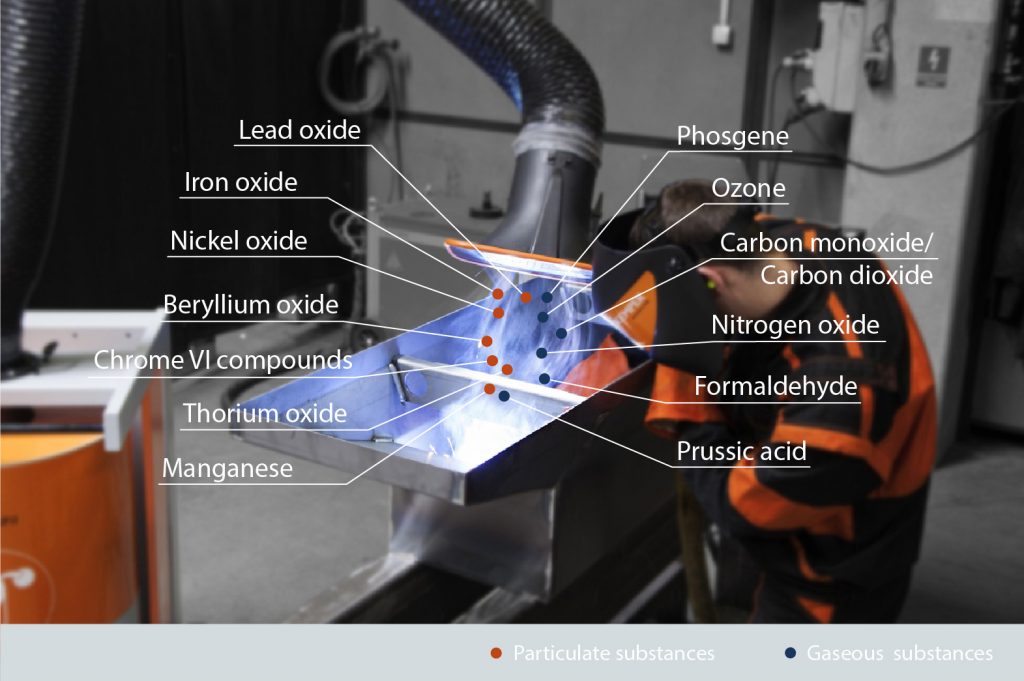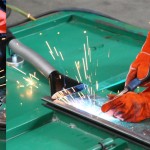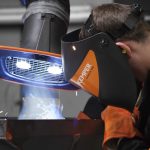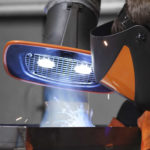Welding fumes explained in brief: Why an extraction system is so important
Every metal processor should know these days that welding fumes are harmful. Yet, one question gets asked over and over again: What are welding fumes exactly? Just looking at the composition gives an indication of what hazards are behind welding fumes and why welding fume extraction is important.
“Welding fumes, what are they exactly?”, is something many welders still ask today. In fact, occupational safety is a fixed part of any lesson plan during training. Despite this, it is a rather niche topic for aspiring welders, since it does not have anything to do with the finest welding seam. However, this is exactly what makes knowledge about welding fumes so valuable: it is about your own health. A few points up front: Only 5 percent of welding fumes come from the base material of the workpiece that is being processed. About 95 percent come from processing the welding consumables.
Welding fumes penetrate the lungs
Welding fumes are a hazardous cocktail of gases and particles. Particles are divided into two size ranges (fractions). The inhalable fraction includes all particles up to a limit of 100 µm – this corresponds to 0.1 mm. These are breathed in through the mouth and nose.
The second – alveolar (respirable) – fraction includes particle sizes of up to 10 µm. This fraction includes fine dust up to the ultra-fine range. Welding fume particles are mostly smaller than 0.1 µm and are thus classed as ultra-fine. The quantity of particles released during welding depends on the materials used, welding meterials and the welding processes used.
For manual arc welding with coated rod electrodes made of chrome-nickel-steel e.g., individual particles with a diameter of 50 to 400 nm occur. Even the particle chains which can form just about reach 500 nm. The smallest particles produced by gas-shielded welding of aluminum alloys are just 10 to 50 nm large.
Welding fumes: alveolar and mutagenic
But what does this mean for respiration? When breathing in, welders inhale the hazardous substances through the nose and mouth. They either reach the esophagus or windpipe. They reach the bronchial tubes and the lungs via the windpipe.
Due to their size, they are not only able to reach the smallest branches of the lungs and the alveoli, but they can also penetrate cell walls and thus reach air sacs in which the elementary gas exchange occurs between blood and lungs. Due to the fact that they reach the cells, there is a risk that the human genetic material will change and therefore trigger illnesses. As a result, welding fumes have been classified as a cause of lung cancer by the World Health Organization.
Gases in welding fumes present further risks
As if the particles in welding fumes on their own were not not bad enough for the welder’s health, hazardous gases also mix into the welding fumes. This includes shielding gases such as argon or carbon dioxide, gases caused by the welding process and/or gases due to chemicals on the workpiece such as paint, oil or solvents.
When breathing in the welding fumes there is, for example, a risk of suffocation. When breathing in the gases that have been produced, such as carbon monoxide, there is also the risk of suffocation or, in addition, damage to the lungs and breathing organs. Ozone, for instance, plays a significant role in this. Hydrogen chloride or phosgene, as well as hydrogen, formalin or cyanide can be created by foreign substances on the workpiece – substances which can injure the respiratory tract, trigger asthma or present a cancer risk.
Gas or particle shaped
Which hazardous substances in welding fumes are gaseous or particle shaped? Due to a chemical compound of a range of metals as oxide, many welders assume there are just pure gases. However, a range of oxides are present as particles, including:
- aluminum oxide
- iron oxide

- magnesium oxide
- lead oxide
- fluoride
- copper oxide
- manganese oxide
- molybdenum oxide
- chromium(III) compounds
- or nickel and cobalt oxides.
On the other hand,
- nitrogen oxide
- nitrogen dioxide
- carbon monoxide
- or ozone
are also present as gases.
Welding fume extraction today tackles particles above all
Both lists could be extended quite significantly. However, one thing is important. Without downplaying the risks behind the gaseous hazardous substances, due to the problem of particulate matter, the challenge for welding fume extraction to this day is capturing particles. Therefore, filters in extraction technology are mainly designed to tackle particles, whilst the hall air in production facilities can already be kept clear of gases using intelligent ventilation solutions.
This explanation shows: Health risks caused by welding fumes are significant. It’s a good job then that effective welding fume extraction systems can protect welders…





